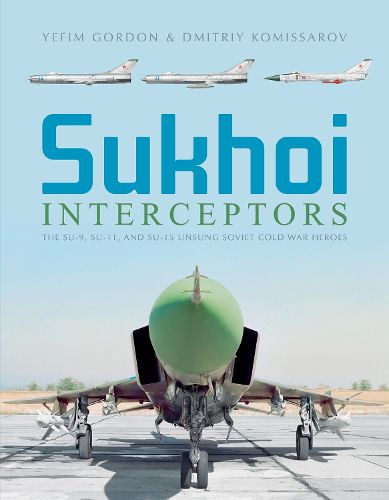Readings Newsletter
Become a Readings Member to make your shopping experience even easier.
Sign in or sign up for free!
You’re not far away from qualifying for FREE standard shipping within Australia
You’ve qualified for FREE standard shipping within Australia
The cart is loading…






Closed in 1949, the Sukhoi Design Bureau was reborn in 1953 to meet an urgent demand for a fast interceptor that would counter the threat posed by NATO bombers. It wasted no time developing a succession of missile-armed, Mach 2 interceptors characterised by delta wings; the single-engined Su-9 entered service in 1960, followed by the up-armed Su-11 in 1964 and the twin-engined Su-15 in 1967. Though built in modest numbers, the three types became an important asset for the Soviet Air Defense Force - particularly the more capable Su-15, which unfortunately became notorious for shooting down two intruding South Korean airliners within five years. The Su-15 outlasted the Soviet Union, the last being retired in 1996. There were also several Sukhoi interceptors that remained in prototype or project form. All known versions are described, as are operational details. The book features many rare and previously unpublished photos. AUTHORS: Yefim Gordon is an aviation journalist and photographer who has been researching Soviet/Russian aviation history for more than 40 years. He has authored and coauthored more than 120 books on the subject and published hundreds of features and photographs in Russian and foreign aviation magazines. Dmitriy Komissarov is a translator and journalist whose work has been associated with aviation since 1993. He has translated or authored/coauthored more than 70 books on Soviet/Russian aircraft and written numerous features for Russian and foreign aviation magazines.
$9.00 standard shipping within Australia
FREE standard shipping within Australia for orders over $100.00
Express & International shipping calculated at checkout
Closed in 1949, the Sukhoi Design Bureau was reborn in 1953 to meet an urgent demand for a fast interceptor that would counter the threat posed by NATO bombers. It wasted no time developing a succession of missile-armed, Mach 2 interceptors characterised by delta wings; the single-engined Su-9 entered service in 1960, followed by the up-armed Su-11 in 1964 and the twin-engined Su-15 in 1967. Though built in modest numbers, the three types became an important asset for the Soviet Air Defense Force - particularly the more capable Su-15, which unfortunately became notorious for shooting down two intruding South Korean airliners within five years. The Su-15 outlasted the Soviet Union, the last being retired in 1996. There were also several Sukhoi interceptors that remained in prototype or project form. All known versions are described, as are operational details. The book features many rare and previously unpublished photos. AUTHORS: Yefim Gordon is an aviation journalist and photographer who has been researching Soviet/Russian aviation history for more than 40 years. He has authored and coauthored more than 120 books on the subject and published hundreds of features and photographs in Russian and foreign aviation magazines. Dmitriy Komissarov is a translator and journalist whose work has been associated with aviation since 1993. He has translated or authored/coauthored more than 70 books on Soviet/Russian aircraft and written numerous features for Russian and foreign aviation magazines.